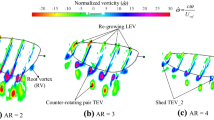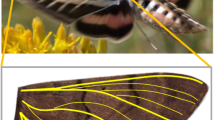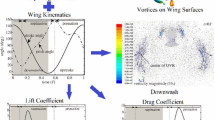Abstract
Numerical investigation of vortex dynamics in near wake of a hovering hawkmoth and hovering aerodynamics is conducted to support the development of a biology-inspired dynamic flight simulator for flapping wing-based micro air vehicles. Realistic wing-body morphologies and kinematics are adopted in the numerical simulations. The computed results show 3D mechanisms of vortical flow structures in hawkmoth-like hovering. A horseshoe-shaped primary vortex is observed to wrap around each wing during the early down- and upstroke; the horseshoe-shaped vortex subsequently grows into a doughnut-shaped vortex ring with an intense jet-flow present in its core, forming a downwash. The doughnut-shaped vortex rings of the wing pair eventually break up into two circular vortex rings as they propagate downstream in the wake. The aerodynamic yawing and rolling torques are canceled out due to the symmetric wing kinematics even though the aerodynamic pitching torque shows significant variation with time. On the other hand, the time-varying the aerodynamics pitching torque could make the body a longitudinal oscillation over one flapping cycle.
Similar content being viewed by others
Abbreviations
- a 0 :
-
acceleration (or deceleration) of the insect wing
- c m :
-
mean wing chord length (reference length)
- C x , C y , C z :
-
dimensionless force coefficients
- C D :
-
dimensionless coefficient of horizontal (drag or thrust) force
- C L :
-
dimensionless coefficient of vertical (lift) force
- C S :
-
dimensionless coefficient of sideslip force
- dt :
-
time increment
- f :
-
flapping wing frequency
- F aero :
-
aerodynamic force
- \({{\pmb F}^{*}_{\rm aero}}\) :
-
dimensionless aerodynamic force
- \({{\pmb F}^{*}_{{\rm aero},i}}\) :
-
dimensionless aerodynamic force of the cell (i)
- i :
-
cell index
- k = 2π f/ (2U ref):
-
reduced frequency
- M m :
-
mass of flight muscle
- n :
-
unit outward normal vector
- O:
-
origin of earth-fixed Cartesian coordinates
- O′:
-
origin of wingbase-fixed Cartesian coordinates
- p :
-
pressure
- \({P^{*}_{\rm aero}}\) :
-
dimensionless aerodynamic power
- P aero :
-
muscle-mass-specific aerodynamic power
- q :
-
flux vector with respect to pseudo-compressibility
- q*:
-
communication vector in overlapping zones of the two grids
- \({{\pmb r}_i^{*}}\) :
-
dimensionless positional vector of the cell (i)
- R :
-
wing length
- Re :
-
Reynolds number
- S(t):
-
surface area of the control volume
- S w :
-
planform area of a wing
- t :
-
dimensionless time
- T :
-
dimensionless period of one flapping cycle
- \({{\pmb T}_{{\rm aero}}^\ast}\) :
-
dimensionless aerodynamic torques
- T aero :
-
aerodynamic torques
- u, v, w :
-
x, y, and z velocity components in the Cartesian coordinate system
- U ref :
-
reference velocity at the wing tip
- V(t):
-
volume of the control volume
- V f :
-
velocity of the insect body
- \({{\pmb v}^{\ast}_{i}}\) :
-
dimensionless velocity of the cell (i)
- x, y, z :
-
wingbase-fixed Cartesian coordinates
- X, Y, Z :
-
earth-fixed Cartesian coordinates
- α :
-
feathering angle (or angle of attack of the wing)
- β :
-
stroke plane angle
- γ :
-
pseudo-compressibility coefficient
- χ :
-
body angle
- \({\Phi}\) :
-
wingbeat amplitude
- θ :
-
elevation angle
- \({\Phi}\) :
-
positional angle (or flapping angle)
- \({\phi _{\rm cn}}\) , \({\phi _{\rm sn}}\) , θ cn, θ sn, α cn, α sn :
-
Fourier coefficients kinematic data of the flapping wing
- ρ :
-
air density
- τ :
-
pseudo time
- ν :
-
kinematic viscosity of air
References
Brodsky A.K.: The evolution of insect flight. Oxford University Press, Oxford (1984)
Brodsky A.K.: Vortex formation in the tethered flight of the peacock butterfly Inachis Io L. and some aspects of insect flight evolution. J. Exp. Biol. 161, 77–95 (1991)
Grodnitsky D.L., Morozov P.P.: Flow visualization experiments on tethered flying green lacewings Chrysopa Dasyptera. J. Exp. Biol. 169, 142–163 (1992)
Grodnitsky D.L., Morozov P.P.: Vortex formation during tethered flight of functionally and morphologically two-winged insects, including evolutionary considerations on insect flight. J. Exp. Biol. 182, 11–40 (1993)
Ellington C.P., van den Berg C., Willmott A.P., Thomas A.L.R.: Leading-edge vortices in insect flight. Nature 384, 626–630 (1996)
Willmott A.P., Ellington C.P., Thomas A.L.R.: Flow visualization and unsteady aerodynamics in the flight of the hawkmoth, Manduca sexta. Philos. Trans. R. Soc. B Biol. Sci. 352, 303–316 (1997)
Van den Berg C., Ellington C.P.: The three-dimensional leading-edge vortex of a ‘hovering’ model hawkmoth. Philos. Trans. R. Soc. B Biol. Sci. 352, 329–340 (1997a)
Van den Berg C., Ellington C.P.: The vortex wake of a ‘hovering’ model hawkmoth. Philos. Trans. R. Soc. B Biol. Sci. 352, 317–328 (1997b)
Dickinson M.H., Lehmann F.-O., Sane S.: Wing rotation and the aerodynamic basis of insect flight. Science 284, 1954–1960 (1999)
Ellington C.P.: The aerodynamics of insect flight. IV. aerodynamic mechanisms. Philos. Trans. R. Soc. B Biol. Sci. 305, 79–113 (1984)
Ellington C.P.: The aerodynamics of insect flight. V. A vortex theory. Philos. Trans. R. Soc. B Biol. Sci. 305, 115–144 (1984)
Shyy W., Liu H.: Flapping wings and aerodynamic lift: the role of leading-edge vortices. AIAA J. 45, 2819–2821 (2007)
Thomas A.L.R., Bomphrey R.J., Srygley R.B., Nudds R.L., Taylor G.K.: Dragonfly flight: free-flight and tethered flow visualizations reveal a diverse array of unsteady lift generating mechanisms, controlled primarily via angle of attack. J. Exp. Biol. 207, 4299–4323 (2004)
Bomphrey R.J., Lawson N.J., Taylor G.K., Thomas A.L.R.: The aerodynamics of Manduca sexta: digital particle image velocimetry analysis of the leading-edge vortex. J. Exp. Biol. 208, 1079–1094 (2005)
Bomphrey R.J., Lawson N.J., Taylor G.K., Thomas A.L.R.: Application of digital particle image velocimetry to insect aerodynamics: measurement of the leading-edge vortex and near wake of a hawkmoth. Exp. Fluids 40, 546–554 (2006)
Poelma C., Dickson W.B., Dickinson M.H.: Time-resolved reconstruction of the full velocity field around a dynamically-scaled flapping wing. Exp. Fluids 41, 213–225 (2006)
Liu H., Kawachi K.: A numerical study of insect flight. J. Comput. Phys. 146, 124–156 (1998)
Liu H., Ellington C.P., Kawachi K., van den Berg C., Willmott A.P.: A computational fluid dynamic study of hawkmoth hovering. J. Exp. Biol. 201, 461–477 (1998)
Wang Z.J.: Two dimensional mechanism for insect hovering. Phys. Rev. Lett. 85, 2216–2219 (2000)
Ramamurti R., Sandberg W.C.: A three-dimensional computational study of the aerodynamic mechanisms of insect flight. J. Exp. Biol. 205, 1507–1518 (2002)
Ramamurti R., Sandberg W.C.: A computational investigation of the three-dimensional unsteady aerodynamics of Drosophila hovering and maneuvering. J. Exp. Biol. 210, 881–896 (2007)
Sun M., Tang J.: Lift and power requirements of hovering flight in Drosophila virlis. J. Exp. Biol. 205, 2413–2427 (2002)
Wang Z.J., Birch J.M., Dickinson M.H.: Unsteady forces and flows in low Reynolds number hovering flight: two-dimensional computations vs robotic wing experiments. J. Exp. Biol. 207, 449–460 (2004)
Miller L.A., Peskin C.S.: When vortices stick: an aerodynamic transition in tiny insect flight. J. Exp. Biol. 207, 3073–3088 (2004)
Miller L.A., Peskin C.S.: A computational fluid dynamics of ‘clap and fling’ in the smallest insects. J. Exp. Biol. 208, 195–212 (2005)
Liu H.: Simulation-based biological fluid dynamics in animal locomotion. ASME Appl. Mech. Rev. 58, 269–282 (2005)
Shyy W., Lian Y.S., Tang J., Viieru D., Liu H.: Aerodynamics of low Reynolds number flyers. Cambridge University Press, New York (2008)
Aono H., Fuyou L., Liu H.: Near- and far-field aerodynamics of insect hovering flight: an integrated computational study. J. Exp. Biol. 211, 239–257 (2008)
Liu, H.: Integrative modeling of insect flight: morphology, kinematics and aerodynamics. J. Comput. Phys. (2008) (in press)
Liu H.: Computational biological fluid dynamics: digitizing and visualizing animal swimming and flying. Integr. Comp. Biol. 42, 1050–1059 (2002)
Willmott A.P., Ellington C.P.: The mechanics of flight in the hawkmoth, Manduca sexta I: Kinematics of hovering and forward flight. J. Exp. Biol. 200, 2705–2722 (1997)
Aono H., Liu H.: Vortical structure and aerodynamics of hawkmoth hovering. J. Biomech. Sci. Eng. 1, 234–245 (2006)
Shyy, W., Udaykumar, H.S., Rao, M.M., Smith, R.W.: Computational fluid dynamics with moving boundaries, Taylor & Francis, Washington (1996, revised printing 1997, 1998 & 2001); Dover, New York (2007)
Shyy W., Sun C.-S.: Development of a pressure-correction/staggered-grid based multigrid solver for incompressible recirculating flows. Comput. Fluids 22, 51–76 (1993)
Willmott A.P., Ellington C.P.: The mechanics of flight in the hawkmoth, Manduca sexta II: aerodynamics consequences of kinematics and morphological variation. J. Exp. Biol. 200, 2723–2745 (1997)
Liu H., Kato N.: A numerical study of unsteady hydrodynamics of a mechanical pectoral fin. J. Bionics. Eng. 1, 108–120 (2004)
Birch J.M., Dickinson M.H.: Spanwise flow and the attachment of the leading-edge vortex on insect wings. Nature 412, 729–733 (2001)
Dickinson M.H., Götz K.G.: The wake dynamics and flight forces of the fruit fly, Drosophila melanogaster. J. Exp. Biol. 199, 2085–2104 (1994)
Viieru, D., Tang, J., Lian, Y., Liu, H., Shyy, W.: Flapping and flexible wing aerodynamics of low Reynolds number flight vehicles. AIAA paper 2006–0503 (2006)
Wang H., Inada Y., Liu H.: A numerical analysis of inertial torques in the steering maneuvers of hovering Drosophila. JSME Int. J. Ser. C Mech. Syst. Mach. Elem. Manuf. 48, 499–512 (2005)
Shyy W., Lian Y., Tang J., Liu H., Trizila P., Stanford B., Bernal L.P., Cesnik C.E.S., Friedmann P., Ifju P.: Computational aerodynamics of low Reynolds number plunging, pitching and flexible wings for MAV applications. Acta Mech. Sin. 24, 351–373 (2008)
Sun M., Wang J., Xiong Y.: Dynamic flight stability of hovering insects. Acta Mech. Sin. 23, 231–246 (2007)
Ellington C.P.: Aerodynamics of insect flight. III. the kinematics. Philos. Trans. R. Soc. B Biol. Sci. 305, 79–113 (1984)
Author information
Authors and Affiliations
Corresponding author
Rights and permissions
About this article
Cite this article
Aono, H., Shyy, W. & Liu, H. Near wake vortex dynamics of a hovering hawkmoth. Acta Mech Sin 25, 23–36 (2009). https://doi.org/10.1007/s10409-008-0210-x
Received:
Accepted:
Published:
Issue Date:
DOI: https://doi.org/10.1007/s10409-008-0210-x




